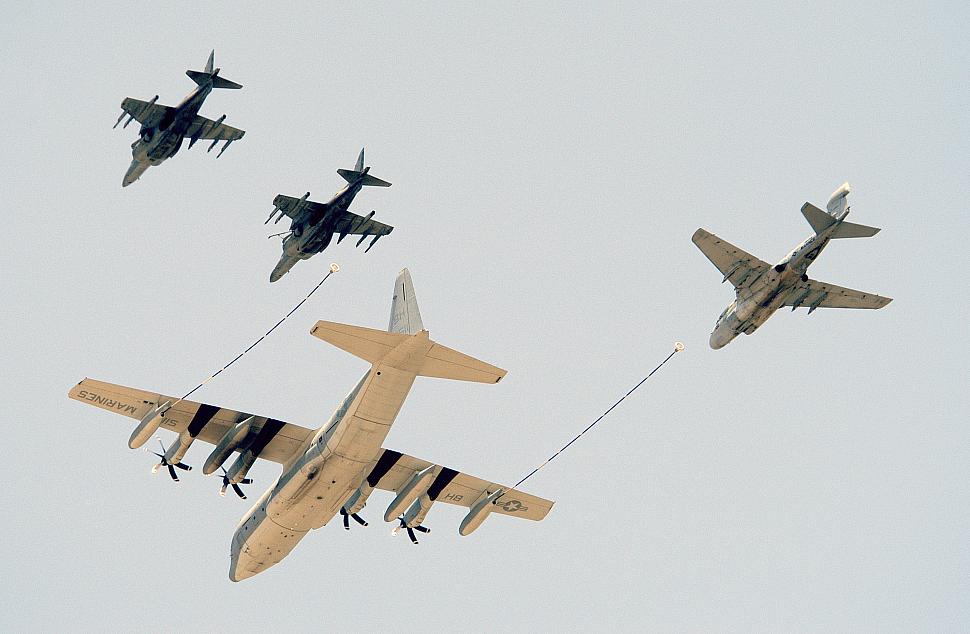C-130 News
C-130 Hercules News
KC-130J makes aerial refueling easier
April 11, 2008 (by
Lance Cpl. Ryan Wicks) -
To ensure this readiness, Marines from Marine Aerial Refueler Transport Squadron 152 conducted a fixed wing aerial refuel training mission April 7 off the west coast of Okinawa with Marine All Weather Fighter Attack Squadron 242.

VMGR-152, also known as the Sumos, utilized the newest KC-130J in its inventory during the three hour mission, refueling two F/A-18D Hornets from VMFA(AW)-242.
Normally the mission would have taken a little longer because the older model planes weren’t as easy to maneuver.
“The new plane is state of the art,” said Maj. Constantinos Koutsoukos, an aircraft commander with VMGR-152. “All we do is give it the information that we have gathered, and it basically takes over. It is a fully automated plane. I could even sit there with my arms crossed the whole mission and have hardly have to do anything.”
As advanced as the system is, however, there is still much to be done beforehand by pilots and crew to ensure a successful mission. Crews must first gather detailed data such as weather conditions, cargo and crew weight, fuel requirements and mission timeline, Koutsoukos said. Then the execution phase begins by preparing the aircraft’s internal operating system.
For the April 7 mission, Koutsoukos, pilot 1st Lt. Joseph Lenox and crew chief Master Sgt. Ian Kubicki took all the data they gathered and entered it into the planes computer. The plane’s operating system used that information to adjust in-flight settings according to the variables such as weight and weather.
Besides having a better “brain,” the KC-130J also has more brawn, according to Koutsoukos.
“We can go higher and move faster than before, which makes it much easier for the jets to refuel and allows them to get back to the fight faster.”
And getting the fighters back in the fight is the “bread and butter” of the squadron, he said.
“The majority of our missions in battle consist of aerial refueling, so we must master that skill,” he said.
Lenox also emphasized the importance of efficient refueling missions.
“In Iraq, for example, the jets provide air support for troops on the ground,” he said. “If (the jets) had to go back to base every time they ran low on gas, it would waste time, fuel and potentially lives.”
With that type of focus, personnel of VMGR-152 conducted the refueling exercise as if it were the real thing.
“Everything was run as if we were in Iraq and fighter planes needed refueling support,” Koutsoukos said. “The only difference is that we did not wear any (personal) protective gear or armor.”
The exercise concluded with two Hornets topped off with fuel and a Sumo crew more confident than ever in their aircraft’s ability to save lives on the battlefield.

USMC KC-130J #166511 from VMGR-252 simulates aerial refueling with an EA-6B Prowler and a pair of AV-8B Harrier II aircraft at the conclusion of the Marine Air Ground Task Force demonstration on May 7, 2005 held at MCAS Cherry Point, North Carolina. [USMC photo PH2 Daniel J. McLain]
Normally the mission would have taken a little longer because the older model planes weren’t as easy to maneuver.
“The new plane is state of the art,” said Maj. Constantinos Koutsoukos, an aircraft commander with VMGR-152. “All we do is give it the information that we have gathered, and it basically takes over. It is a fully automated plane. I could even sit there with my arms crossed the whole mission and have hardly have to do anything.”
As advanced as the system is, however, there is still much to be done beforehand by pilots and crew to ensure a successful mission. Crews must first gather detailed data such as weather conditions, cargo and crew weight, fuel requirements and mission timeline, Koutsoukos said. Then the execution phase begins by preparing the aircraft’s internal operating system.
For the April 7 mission, Koutsoukos, pilot 1st Lt. Joseph Lenox and crew chief Master Sgt. Ian Kubicki took all the data they gathered and entered it into the planes computer. The plane’s operating system used that information to adjust in-flight settings according to the variables such as weight and weather.
Besides having a better “brain,” the KC-130J also has more brawn, according to Koutsoukos.
“We can go higher and move faster than before, which makes it much easier for the jets to refuel and allows them to get back to the fight faster.”
And getting the fighters back in the fight is the “bread and butter” of the squadron, he said.
“The majority of our missions in battle consist of aerial refueling, so we must master that skill,” he said.
Lenox also emphasized the importance of efficient refueling missions.
“In Iraq, for example, the jets provide air support for troops on the ground,” he said. “If (the jets) had to go back to base every time they ran low on gas, it would waste time, fuel and potentially lives.”
With that type of focus, personnel of VMGR-152 conducted the refueling exercise as if it were the real thing.
“Everything was run as if we were in Iraq and fighter planes needed refueling support,” Koutsoukos said. “The only difference is that we did not wear any (personal) protective gear or armor.”
The exercise concluded with two Hornets topped off with fuel and a Sumo crew more confident than ever in their aircraft’s ability to save lives on the battlefield.
Courtesy of U.S. Marine Corps - Stars and Stripes
Related articles:
Forum discussion:
Tags
Forum discussion:
- Start a discussion about this article in the C-130.net forum.
Tags
